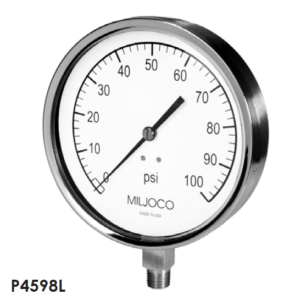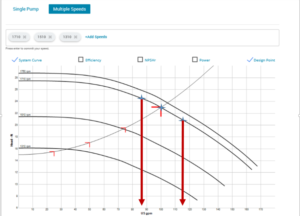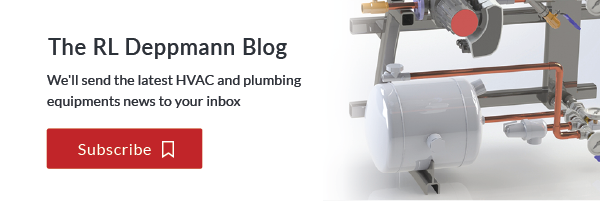Today hydronic pump control, pressure independent balance, ASHRAE 90.1 reset requirements, dual return boiler systems, and other highly technical design options take our attention on every project. Pressure gauges and thermometers for HVAC systems seem to be a pretty bland subject. We become frustrated when adjusting or troubleshooting a system and the indictors we installed do not function or are inaccurate. The next few R L Deppmann Monday Morning Minutes will look at pressure gauges and thermometers.
What Determines the Cost of a Pressure Gauge?
We live in a world where the cost of the equipment and even the cost of the entire system is often challenged. Engineers may hear a variety of questions about their choices. They hear some form of the question, “why did you specify something that expensive”? The cost in pressure gauges gets down to accuracy, size, and materials. Let’s look at each briefly.
The Range of the Pressure Gauge
The range of a pressure gauge is pretty simple. We want a gauge where the normal reading is in the midpoint of the gauge. We also want a gauge where the maximum pressure or relief valve setting is in the range.
Accuracy of Pressure Gauges
Many of us complain about the accuracy of the indicators in our hydronic and plumbing systems. Often the failure of a gauge to remain accurate is more about the trim than the gauge. I’ll cover that in the next article. ASME, the American Society of Mechanical Engineers, provides a standard for the accuracy of a pressure gauge. Some of the ASME B40.1 ratings are listed as Grades B, 1A, AND 2A. There are many others but these will do for our purposes. Grade 2A is ±1/2% accurate across the entire range. Grade 1A is ±1% accurate across the entire range. In general, the accuracy across the pressure range does not include the bottom 10% and top 10% of the range. Grade B is 3%-2%-3% accurate. This means the gauge is 2% accurate in the middle 50% of the range and 3% accurate in the lower and upper range.
The question becomes how accurate of a gauge do we need? If I have a 100 PSIG grade 1A gauge, a 60 PSIG reading will be ±1% of the range or potentially 1 PSIG off. Does it matter? In our world a static pressure reading normally needs only to be close. Why spend money on a ½% accurate gauge?
The only place I would recommend a Grade 2A pressure gauge is on the circulating pump. In the pumping application, we are reading the difference between two gauges and a few feet can make a big difference. How about an example.
Let’s assume we have a coil pump with a capacity of 100 GPM at 23 feet of head and the system requires 100 PSIG gauges. When I read out the pump at design conditions in this example, I read a suction pressure of 25 PSIGand a discharge pressure of 35 PSIG. The difference is 10 PSIG. It appears I am at design flow rate of 100 GPM. If my reading is off by 1%, the actual flow rate may be as low as 87 GPM and as high as 115 GPM. Pump readout is the place you want accuracy.
I would recommend the specification to read as follows.
Pressure gauges at pumps shall have an ASME B40.1 grade of 2A or better, ±1/2%of the entire range. All other gauges may be ASME B40.1 grade 1A or better, ±1% of the entire range.
Size of the Pressure Gauge
Does size matter? Pressure gauges come in a variety of sizes. The normal sizes used in HVAC systems are 2-1/2”, 4”, 4-1/2”, and 6”. There are other sizes available but those are most common. The issue of size is the ability to read it while standing near the gauge. The standard in the industry is either 4” or 4-1/2”. Why such a slight difference? 4-1/2” was a standard size in the United States while 100mm or 4” was a standard in other parts of the world. In the global economy of today, there is little reason to manufacturer two gauges that close together so the best decision was to manufacture a 4” pressure gauge. There are some advantages to being able to read a 6” gauge if it is mounted up in the air but there is a significant cost penalty. There is also the problem of determining at bid time whether a gauges is 5’ from the floor or 6’ from the floor.
For this reason, I would recommend the specification to read as follows:
Pressure gauges shall have a 4” or larger dial.
Materials of the Pressure Gauge
HVAC systems use a variety of materials. Copper, steel, aluminum, stainless, and resins or plastic. There is little reason in HVAC to be too concerned about the materials of construction as long as they are compatible with the liquid in the system. In plumbing systems we obviously want low lead and something that will not rust.
The case, ring and pointer are all exposed to the atmosphere. This article is about HVAC systems and not a chemical process plant. The case and ring can be stainless steel, reinforced nylon, aluminum, or reinforced polypropylene. All are acceptable. Each manufacturer will promote their standard materials but in the end, does it matter? Most “contractor gauges” or cost effective gauges are stainless steel so that is what I would base the specification on.
The “tube and socket”or bourdon tube is the part that touches the liquid. The standard materials for this are phosphor-bronze, brass, and stainless steel. All are fine for HVAC hydronic systems. In plumbing systems we want to specify low lead content products. One specification point that may become important is the solder used in the gauge. We recommend a high temperature solder so the pressure gauge will be rated from -40°F to 200°F. Most of us don’t have time to check submittals for chilled water gauges that are different from heating.
If we go to the expense of a Grade 2A gauge for pumps, then we might specify stainless steel rotary movement to keep the accuracy over a longer period of time. The standard bronze or brass movement will wear and the accuracy will drop. Again pumps are where the accuracy is needed.
I would recommend the specification to read as follows:
Hydronic: Pressure gauges shall have cases and rings made of stainless steel, nylon, or polypropylene. Tubes and sockets shall be phosphor-bronze, brass, or stainless steel. Solder used shall be high temperature. Movement shall be stainless steel for grade 2A gauges and brass or stainless steel for Grade 1A gauges. Gauges shall be rated for liquid temperatures from -40°F to 200°F.
Plumbing: Pressure gauges shall have cases and rings made of stainless steel, nylon, or polypropylene. Tubes and sockets shall be low lead stainless steel meeting the requirements of the US Safe Drinking Water Act. Movement shall be brass or stainless steel. Gauges shall be rated for liquid temperatures to 200°F.
R. L. Deppmann represents Miljoco pressure gauges and thermometers. The Miljoco manufacturing facility is located in Michigan. They have a funny name with a great story. Click here to learn more about the name.
It is normally advisable to base the specification or schedule on a brand you can trust will meet your specification. Although there is nothing special in the suggested specifications above, I would appreciate if your specification included the following.
Hydronic and steam pressure gauges located at pumps shall be MILJOCO series P4509LX. Hydronic and steam pressure gauges, other than pumps, shall be MILJOCO series P4598L. Plumbing pressure gauges located at pumps shall be MILJOCO series P4509L-PBF. Plumbing pressure gauges, other than pumps, shall be MILJOCO series P4598L=PBF. Pressure gauges meeting this specification and supplied by: (insert other names) will be acceptable.
Next week the R L Deppmann Monday Morning Minutes will look at pressure gauge accessories.



